10 Big Podcasting Takeaways from 2019’s Infinite Dial Research

Each year, Edison Research & Triton Digital’s Infinite Dial research grows in importance for the podcast industry. Podcasters host viewing parties to watch the research being unveiled. This year, the research was reported by the New York Times, Forbes, TechCrunch, and more. Why? It’s been a very, very good year for podcasting.
Tom Webster, Senior Vice President at Edison Research, was kind enough to share his personal insights taken from this year’s data.
1. Young listeners are doing things differently
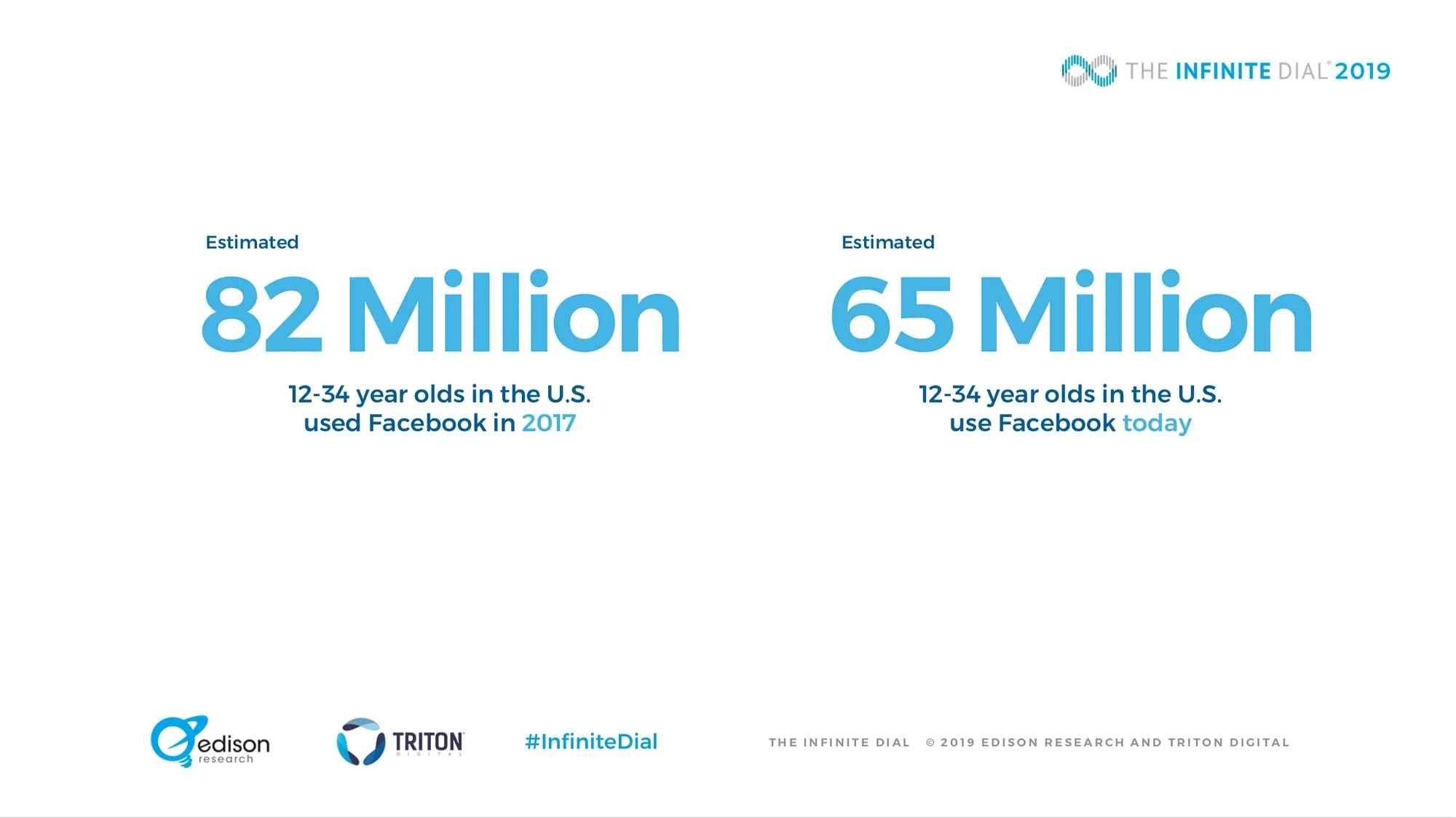
If you look across all of the 2019 Infinite Dial research, there seems to be a big demographic trend — 12–24 year-olds are acting very differently than older demographics. They index much higher on overall Spotify usage, they have increased their podcast listening massively on Spotify, they listen to music on YouTube significantly more, and they have left Facebook in significantly larger numbers.
Tom: I think you’re onto something with that. There is significant, roiling activity with 12 to 24 year-olds in terms of media habits.
We saw that with the Facebook data that we put out. Facebook and Instagram put together aren’t as big as Facebook used to be with that demo. I mean I have a teen myself. His habits are remarkably different from mine. He doesn’t even have a Facebook account. He could, but he doesn’t.
There are a lot of teens out there whose primary source of music, and music discovery, is YouTube.
So things are changing significantly. I think that they’re absolutely finding their own path.
And as far as podcasting growth is concerned, I think it’s a combination of this younger demographic a) finally discovering podcasts where they hadn’t necessarily had them put in front of them before (i.e. Spotify), but also b) also there’s just more content available for them, especially for teens.
2. The Spotify Factor 🍌🍌🍌
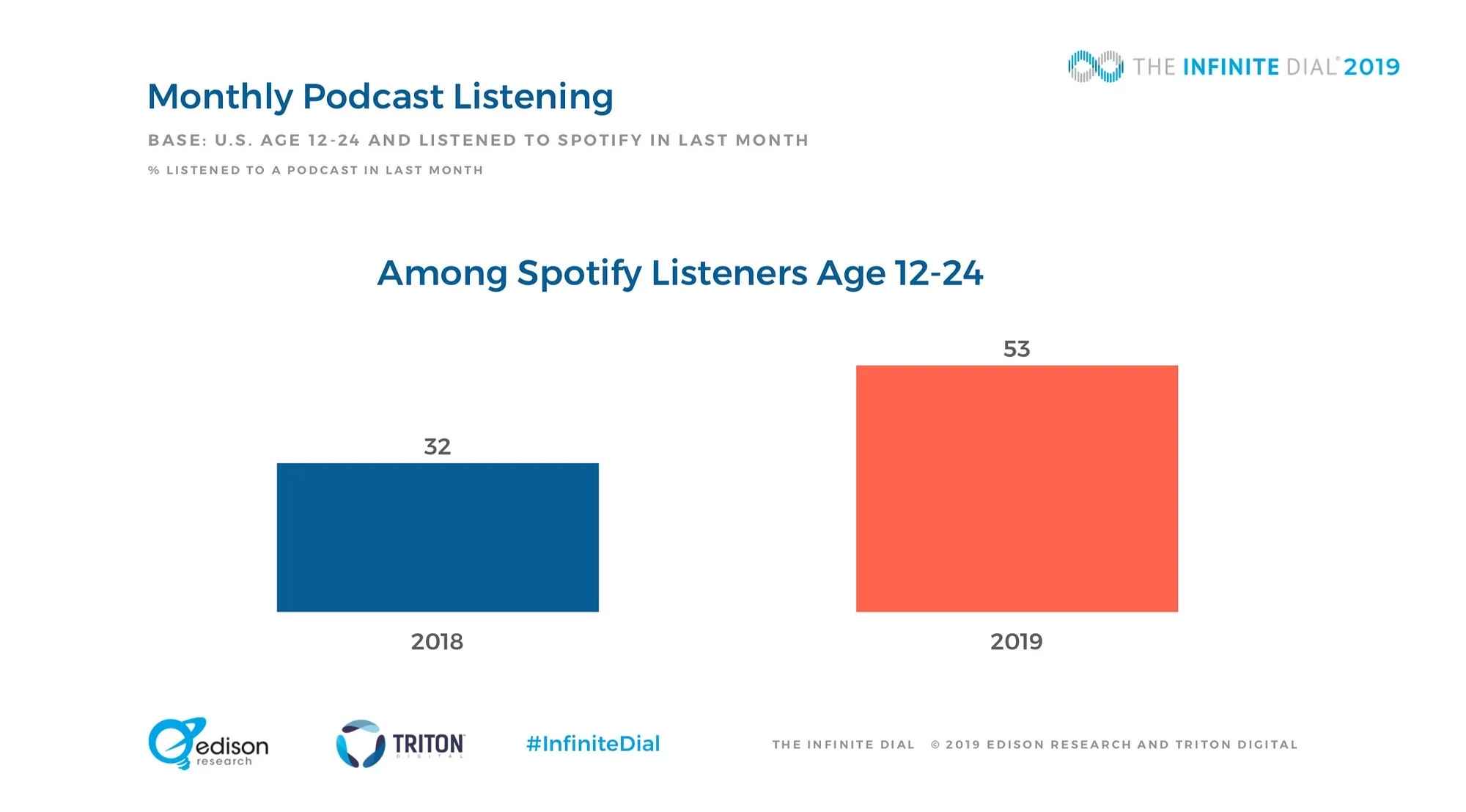
Spotify generated a lot of podcasting news with their early 2019 acquisition of Gimlet and Anchor, but even prior to that, Spotify’s push into podcasting has been having an impact.
Tom: I want to be careful not to say Spotify has caused anything because there are multiple causes and the story is complex but… Spotify is definitely associated with it.
You can’t ignore the fact that a) 12-24 monthly consumers of podcasting went up by a third year over year, which is bananas. But b) if you’re a 12–24 Spotify listener, it went up by two thirds year over year, which is a lot of bananas.
Steve: So what made the difference? Is it changing the user interface to showcase podcasts to more music listeners? Is it more podcasts designed for younger audiences?
Tom: They’re absolutely spotlighting and showcasing content on their app. They clearly made a concerted effort to increase podcasting’s visibility. They also have great algorithms to give you something else based on stuff you’ve already liked. That’s a big part of it.
3. Don’t underestimate Pandora
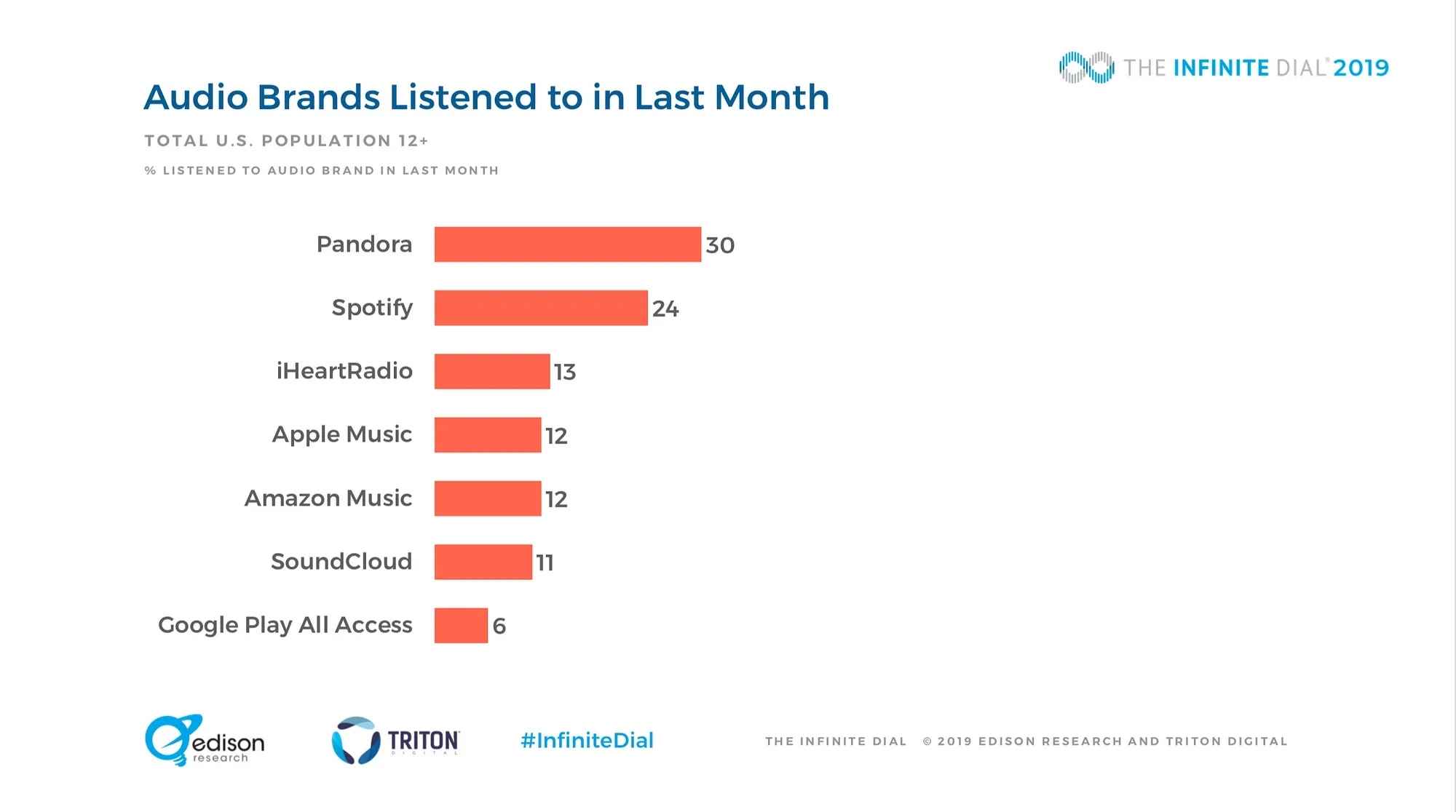
Pandora, recently acquired by SiriusXM, is getting into podcasts in a big way. They’ve got a Podcast Genome Project designed to recommend podcasts that are tailored to each individual listener, they’ve got an original content team from SiriusXM creating new shows, and they’ve got a VERY large audience.
Tom: I think Pandora’s the other shoe that’s going to drop here. Pandora is still the leading service in terms of reach in the United States. They’re really good at personalized recommendations, too, and they are absolutely going to be more active in the podcasting space.
Steve: So what do you see as the key differences between Spotify and Pandora? They are both cross-platform apps with strong recommendation engines. Who chooses one over the other and why?
Tom: Pandora is engineered from the ground up to be a real lean-back experience. Give it a song and off it goes. Whereas Spotify is a little bit more user driven than that in terms of requesting specific songs.
Also, Pandora is largely ad supported and Spotify is largely premium, so they’re two very different business models that both work.
Both are going to continue to coexist, both are going to continue to be successful, and both are going to find their way with podcasts.
4. YouTube could be the next platform for podcasts
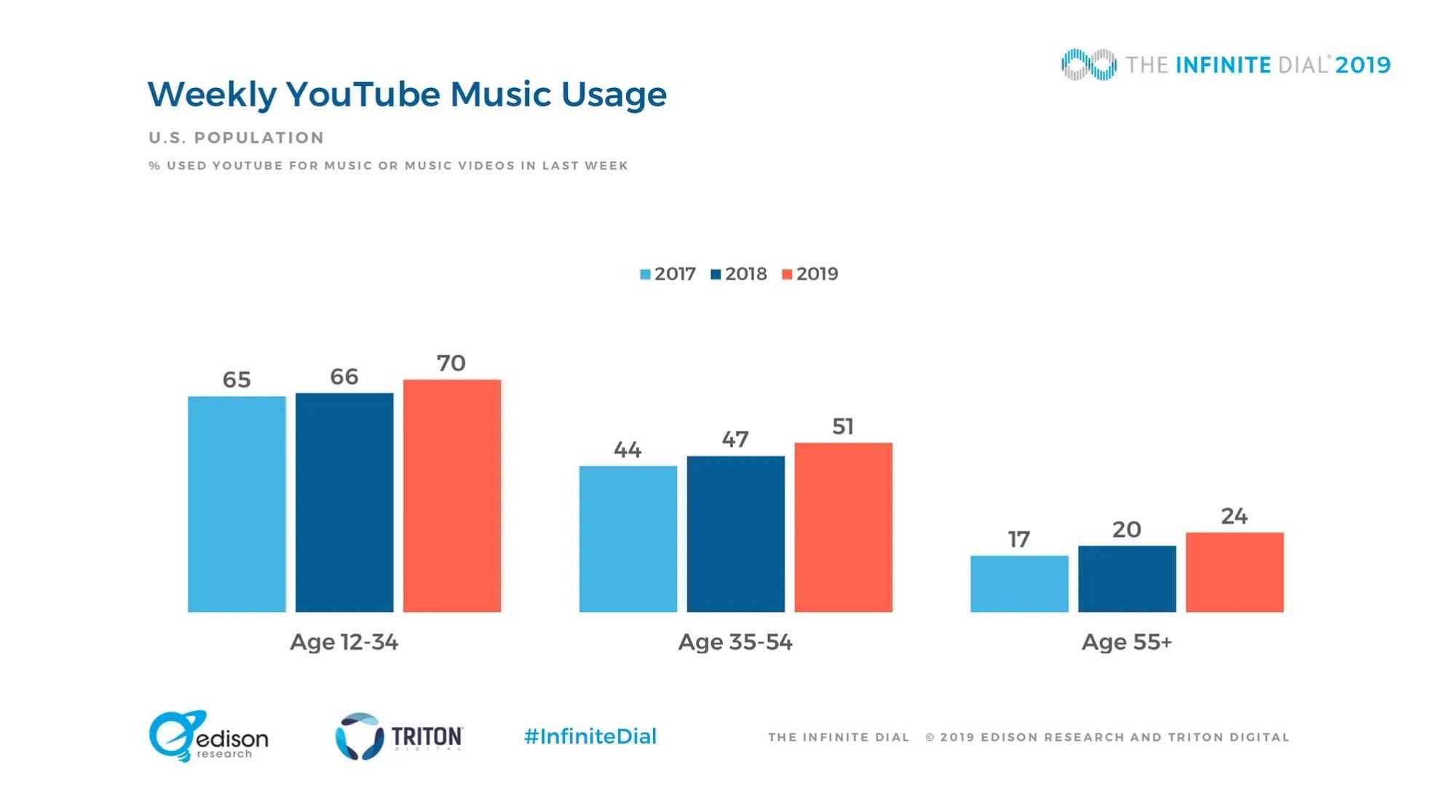
YouTube is a massive music platform for younger demographics. Most interesting, much of the usage is listening, not watching. It’s the ease of access to music on demand.
After hearing Cara Meverden of Scout.fm make a bold YouTube podcasting prediction, and seeing how much younger demographics are using YouTube in non-traditional ways, I wanted Tom’s thoughts about the future potential of YouTube for podcasting.
Tom: I think it’s a sneaky good way to distribute content, especially in that younger demo. The weekly YouTube music usage 12–34 is 70% and it really comes down to the recommendation algorithm YouTube can offer you.
Spotify has got a program on right now that’s kind of a history of The Clash. If I’m watching Clash videos on YouTube and that gets recommended to me, I’m in on that.
5. What advantage do Spotify, Pandora, and YouTube have in common? They’re all cross-platform.
There’s no data in the Infinite Dial about iOS versus Android consumption of podcasts — watch for that soon in Edison’s forthcoming Podcast Consumer report. However, seeing Spotify firmly take hold of the #2 position in podcast usage in 2018, I asked Tom about the importance of being available on both Apple and Android devices.
Tom: It’s a huge factor. Every time I hear a podcast say “Subscribe to us on Apple Podcasts or check us out on Google Podcasts or click Stitcher” and they just go through this long, long list, it’s like a cry for help to me.
The fact that Spotify and Pandora are strong cross platform apps — it just does away with that whole issue and it honestly removes a serious roadblock to distribution that the people who have yet to discover podcasting absolutely have.
So we don’t have to worry necessarily about giving a laundry list of all the places you can subscribe to. You just say “Listen to us on Pandora or listen to us on Spotify.” That’s pretty easy to do.
6. Major changes will happen with in-car listening… in the future
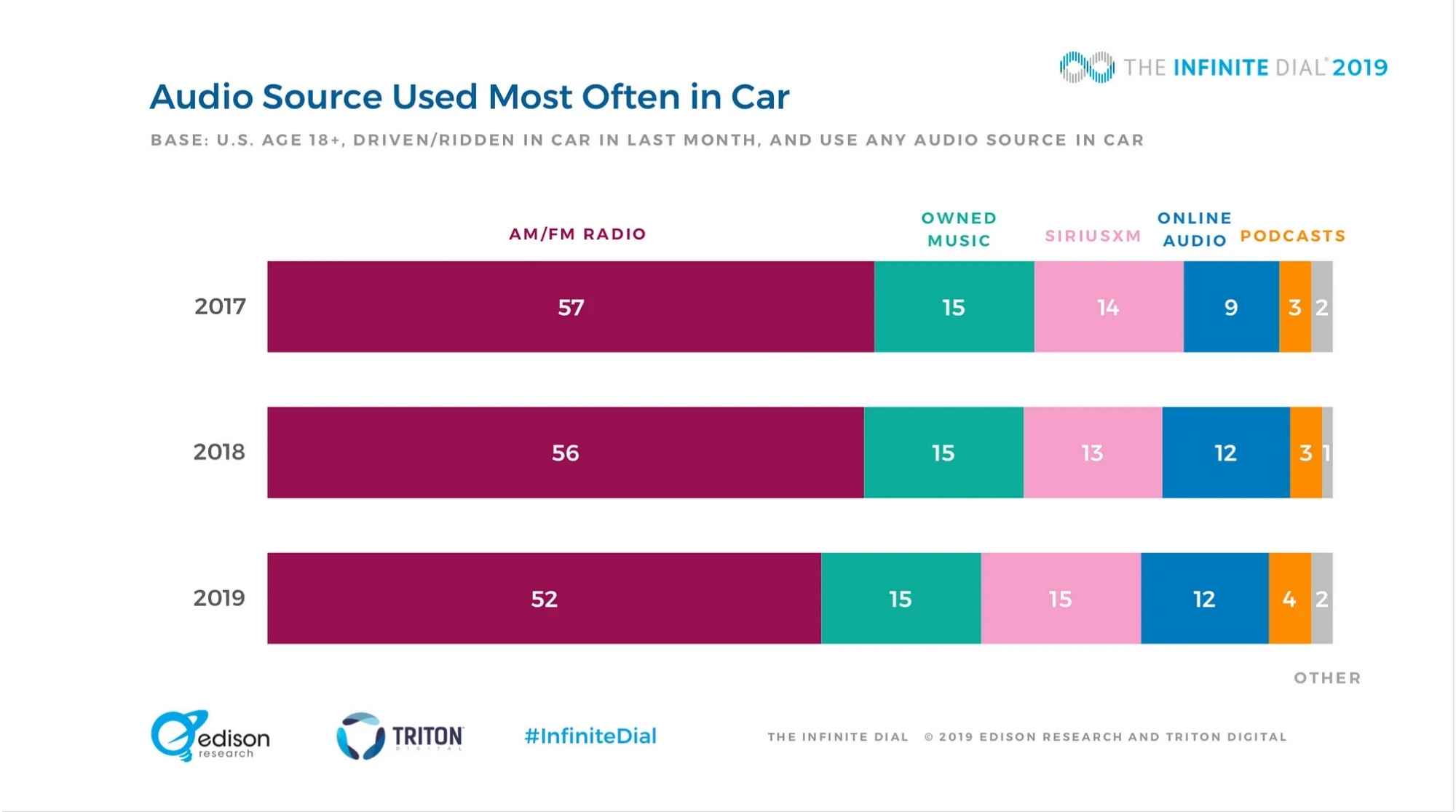
I know that I am an outlier. As a huge podcasting nerd, I have been listening to podcasts and streaming music in my car for years. Without fail, with every year’s Infinite Dial research, I am surprised by how little change there is with in-car listening behavior. Tom told me why I should stop being surprised.
Tom: There’s no doubt that as more internet-based technology gets incorporated in the vehicle, that you’re going to continue to see erosion on the AM/FM numbers.
As the percentage of people who plug in their phones in the car or have an in-dash entertaining system goes up, the percentage of people who say that AM/FM is what they listen to the most goes down, but it hasn’t gone off a cliff. There’s a couple reasons for that.
Here’s the thing that I think people who are really into podcasts have a hard time accepting: a lot of people choose to listen to the radio. They have other options and they choose to listen to it. Why?
If there’s one time during the day where a commercial radio station is really going to pull out the stops to entertain you it’s going to be during those drive times. Many of them will have a live and local show. They’ll be funny. They’ll be entertaining. There will be a lot of commercials and people may switch around.
But a lot of people really do choose the radio in the morning. It’s not falling off a cliff in a way that newspapers did because of the internet.
Steve: One stat I did notice this year was a 4% increase in in-dash entertainment units. How fast will that number will continue to grow and what impact it will have on in-car listening habits?
Tom: In the next few years, it’s not significant because new car sales just don’t turn over that much. Let’s project out a few years, though: it’s going to make a huge difference.
We already know this from research that we’ve done. We did a report called the Commuter Code. We actually put Go Pro cameras mounted into the cars of a sample of commuters, and we aimed the camera at whatever they used to entertain themselves, whether it was their radio, or an in-dash entertainment system or even their smartphone.
Right off the bat, we learned that people that access internet-driven media in their car switch a whole lot less. The more content people had access to, the less they switched, because they could find exactly what they want. That’s one aspect of it.
But I think another aspect of it is that smart speaker technology is going to get baked into cars really, really soon. When I can just ask for the show I want without taking my eyes off the road, then all bets are off on what the most popular media in cars is going to be.
Steve: What can podcasters can do right now to grow in-car listening?
Tom: It’s a real simple one, and people resist this all the time. I get this question all the time: “How long should my podcast be?” If you want to reach listeners in the car, then my advice would be to think about how long that commute is. What are people’s needs are during that commute? How much attention people will be able to pay to a podcast while they’re driving?
Again, if you think about a radio morning show, you can dip in and dip out of that. If I’m telling a really intricate story that requires detailed attention, my morning commute’s not where I’m going to consume that. I’ll find some other place.
Think about the audience!
7. The 2019 Smart Speaker opportunity — solving for context
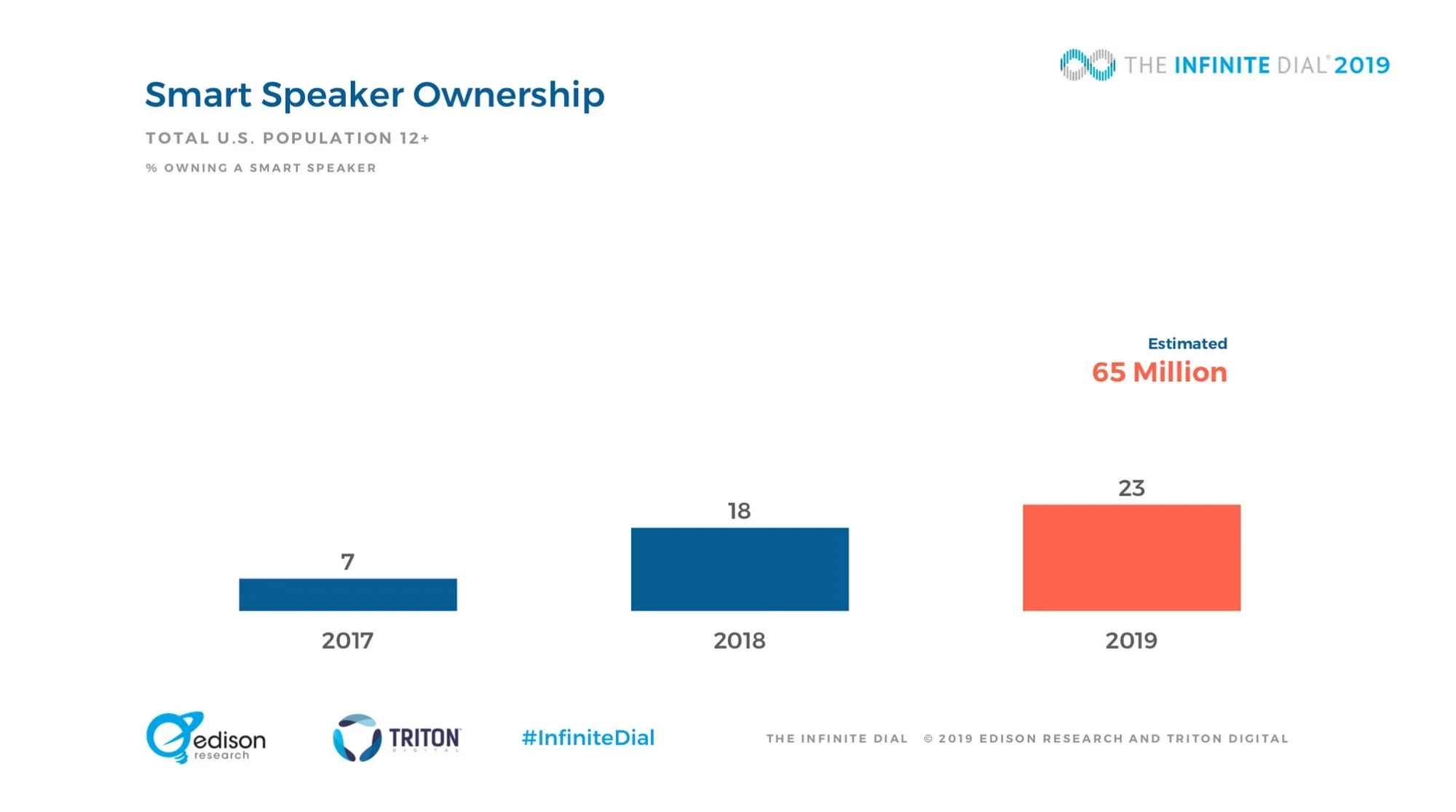
There are over 65 million people with smart speakers in 2019. I wanted to know why we haven’t seen the killer app yet. Why is it primarily being used to play music, listen to the radio, and set kitchen timers? Tom has a snappy comeback.
Tom: That is the killer app.
People still buy these overwhelmingly to listen to audio, predominately music but all forms of audio. It doesn’t sound like it’s anything ground-breaking but it’s a radio in the bathroom for people that didn’t have one before.
We use ours in the kitchen and we probably use it 30 times a day. It’s not to recite prime numbers or the Fibonacci sequence or anything like that.
It’s to time tea.
Steve: Social listening is much more common with a smart speaker, compared to podcasting, which is more often a solitary listening experience. How should podcasters think about content on smart speakers?
Tom: The experience of listening to what has passed to date as a podcast is not necessarily great on a smart speaker.
As a long-time media researcher, one of the things that always fascinates me is not just what people consume, but where, when and why they consume it.
So I would look at contexts. I would look at the context in which people are likely to listen to a podcast, especially with smart speakers now. There’s a smart speaker in my kitchen and that gets my brain going. Like what kind of podcast do I want to hear in the kitchen? What am I doing in the kitchen? Do I just want to hear cooking podcasts? Maybe, maybe not. But what else could I be doing?
When I’m sitting here in front of my laptop and I need to concentrate on my job, is there a place for a podcast there? What would that podcast be? I think about that.
There’s a huge parents and children thing with smart speakers where families are listening specifically with the intention of reducing screen time. That’s powerful.
8. The surprising stat that didn’t change
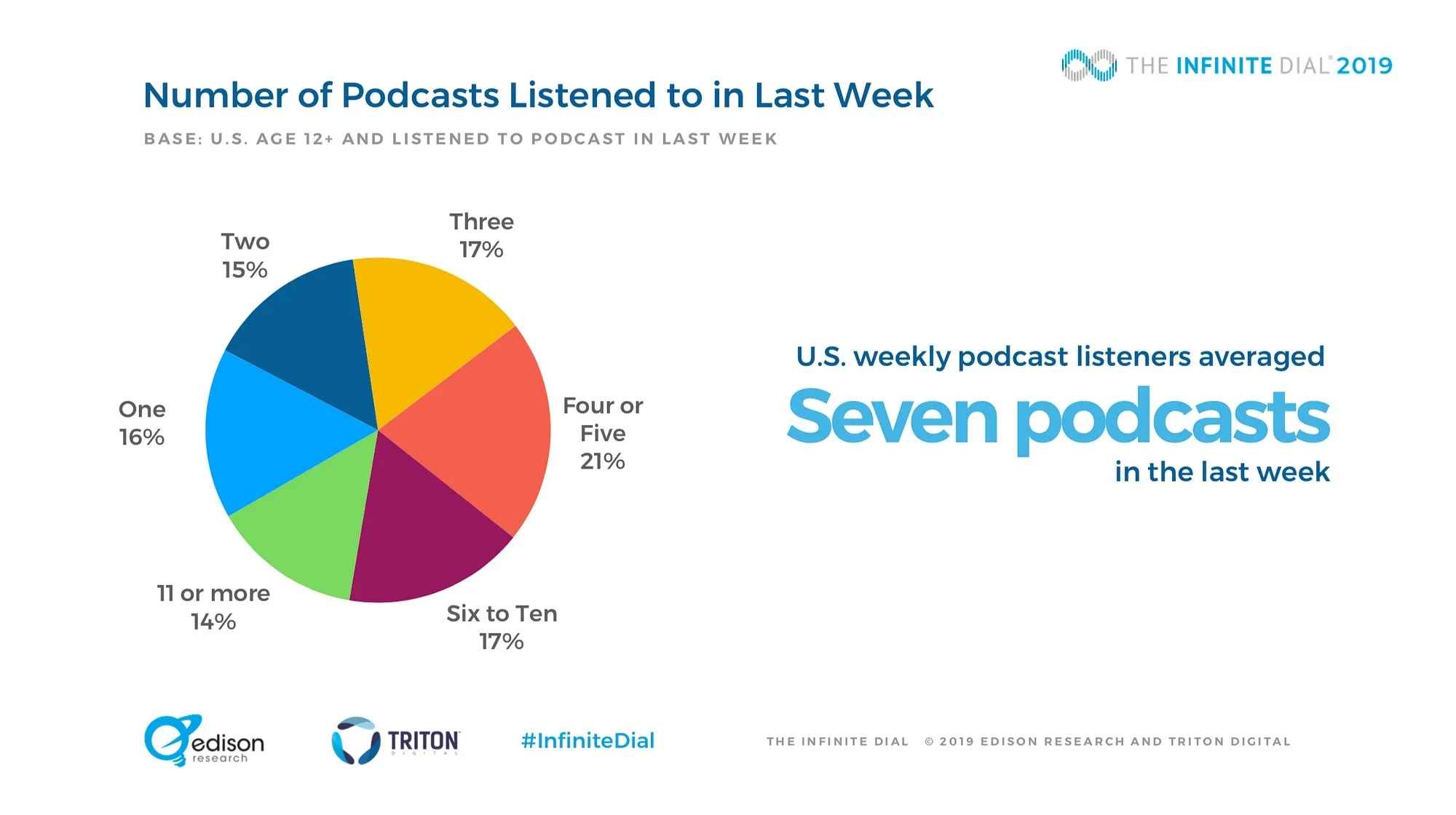
Last year, podcast listeners consumed an average of 7 podcasts a week. This year, the number was exactly the same. This might be an easy one to gloss over, but to Tom, this is actually one to pay attention to.
Tom: In media research, it’s a number that I would have expected to go down as we saw such a big increase in podcast listeners.
I think it’s something people would look at who are not necessarily savvy with data, who look at the fact that the number of podcasts listened to per week hasn’t changed. But I think given the significant influx of new listeners, the fact that stayed at 7 either means that all of these new people also are now listening to 7 podcasts a week, or the existing audience is listening to 15 podcasts a week or whatever.
Either way the fact that the number didn’t change year to year masks a significant amount of consumption.
9. Yes, podcasts went mainstream last year, but podcasters need to think differently to keep the growth going.
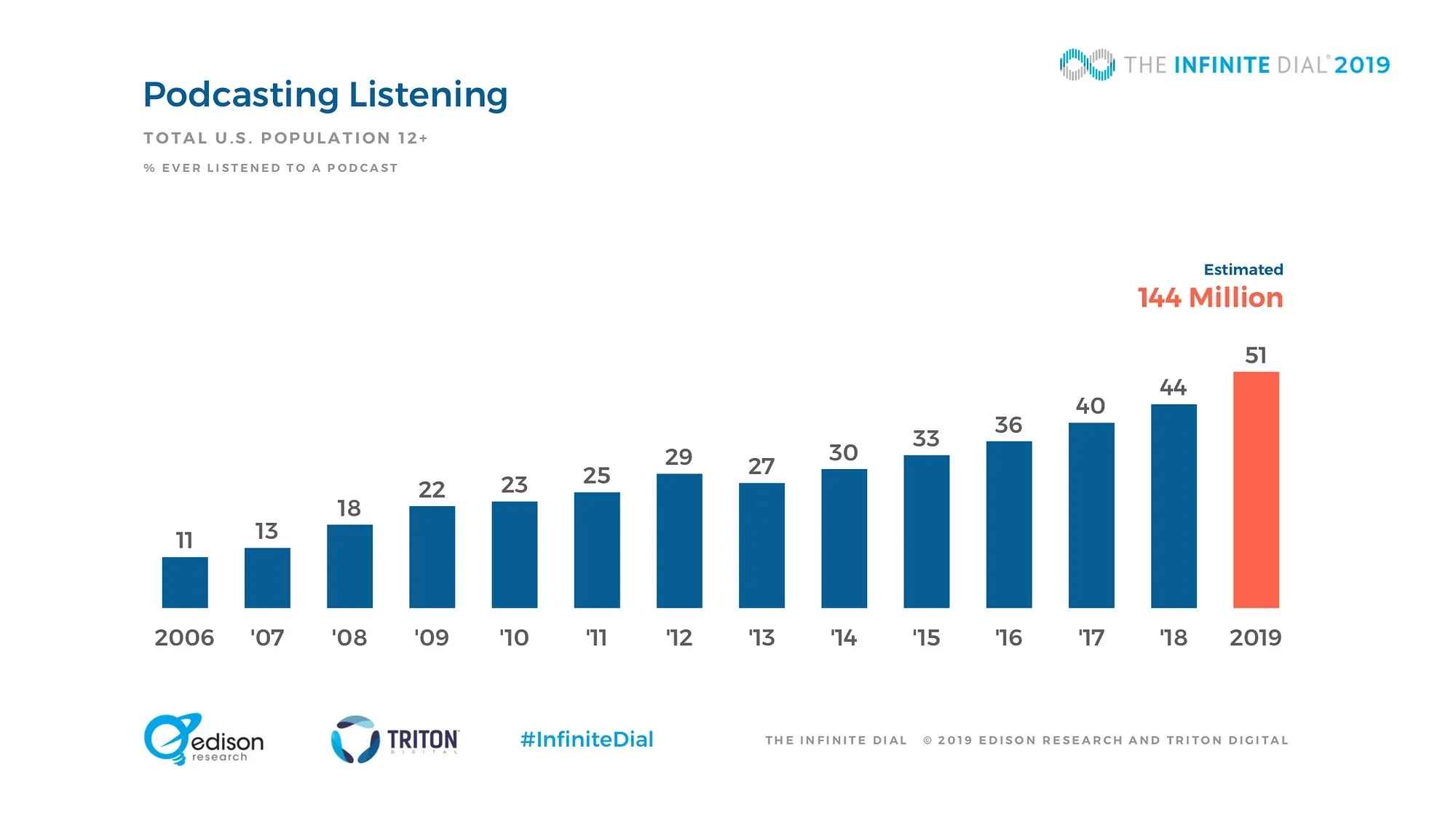
Podcasting legitimately became a mainstream medium in the past year, with 51% of Americans having tried a podcast before. And the 6-point jump in monthly listeners, from 26% to 32%, is the largest since Edison started doing the research in 2006. What does podcasting need to do to keep it going? New thinking and new formats.
Tom: What got us here is not going to get us there. What got us here is what we have. What’s going to get us there is going to be starting to appeal more to people that watch Dateline at night.
We have content companies like Wondery, for example, that are putting out content that you could watch on Lifetime TV tonight. It’s the broad concept, mass appeal, mainstream, really compelling content. And you’re seeing this crossover from podcasting to Hollywood. Things like Dirty John and Homecoming. People are becoming more aware of podcasts as the content is appealing to different people.
For continued growth, you’re going to need to see more and more and more of that.
10. Where would Tom put his money in podcasting? Music.
As far as I know, Tom doesn’t have Luminary money under his mattress to fund a network of podcasts… but if he DID, I wanted to know what he would do with it.
Tom: If I had a lot of money to invest, I know exactly what I would do. I would use it to arm wrestle the record companies into a less Draconian music licensing scheme and I would start music podcasts. The only true cap on podcast consumption is the fact that it’s spoken word. There is a finite cap on spoken word and it’s not going to be 100% of the available audience.
Thanks to Tom and the Infinite Dial teams at Edison Research and Triton Digital for the research and the insights. If you’re not already reading Tom on Medium, I’d highly recommend it. You can get the full 2019 Infinite Dial report here.
Sign up for the Pacific Content Newsletter: audio strategy, analysis, and insight in your inbox. Once a week.
